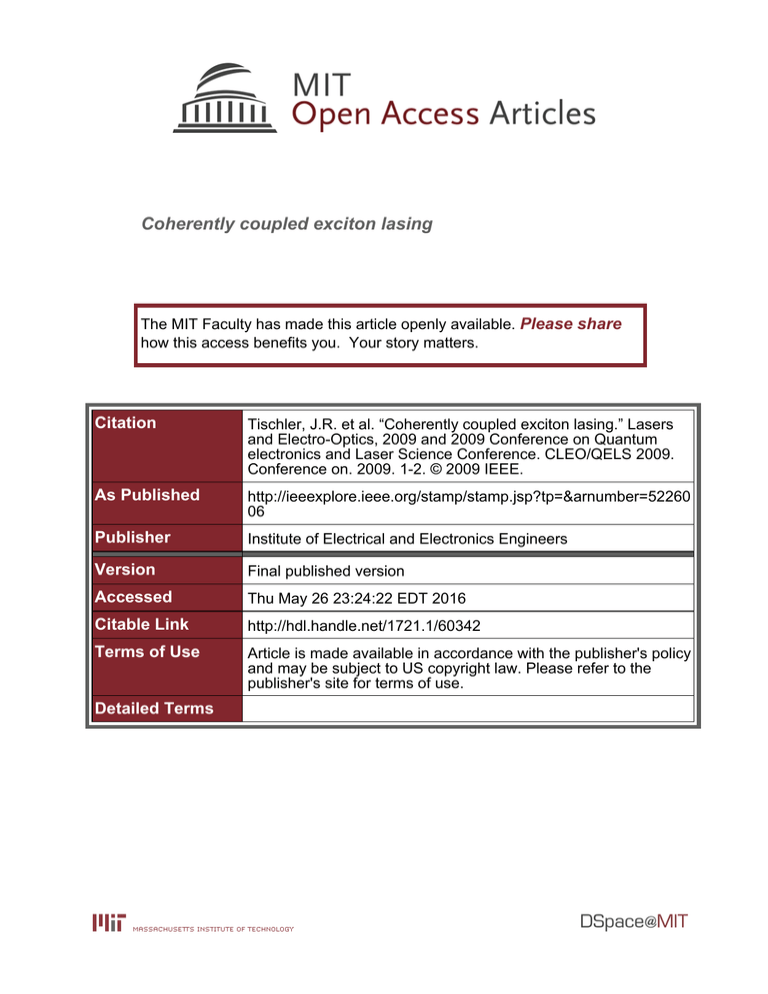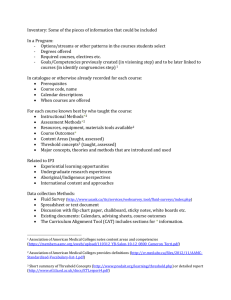Coherently coupled exciton lasing Please share
advertisement

Coherently coupled exciton lasing The MIT Faculty has made this article openly available. Please share how this access benefits you. Your story matters. Citation Tischler, J.R. et al. “Coherently coupled exciton lasing.” Lasers and Electro-Optics, 2009 and 2009 Conference on Quantum electronics and Laser Science Conference. CLEO/QELS 2009. Conference on. 2009. 1-2. © 2009 IEEE. As Published http://ieeexplore.ieee.org/stamp/stamp.jsp?tp=&arnumber=52260 06 Publisher Institute of Electrical and Electronics Engineers Version Final published version Accessed Thu May 26 23:24:22 EDT 2016 Citable Link http://hdl.handle.net/1721.1/60342 Terms of Use Article is made available in accordance with the publisher's policy and may be subject to US copyright law. Please refer to the publisher's site for terms of use. Detailed Terms a2731_1.pdf IThN4.pdf IThN4.pdf © 2009 OSA/CLEO/IQEC 2009 Coherently Coupled Exciton Lasing Jonathan R. Tischler1, Elizabeth R. Young2, Daniel G. Nocera2, Vladimir Bulović1 1. Department of Electrical Engineering and Computer Science 2. Department of Chemistry Massachusetts Institute of Technology, 77 Massachusetts Avenue, Cambridge, MA 02139 email: bulovic@mit.edu Abstract: Lowest reported threshold organic semiconductor VCSEL (4.9 μJ/cm2) is achieved when excitons coherently couple, upon sub-picosecond non-resonant optical excitation. Temperature dependence of λ/2n device, absent in ≥ λ/n cavities, indicates excitons undergo condensate-like phase transition. ©2008 Optical Society of America OCIS codes: (000.2690) General Physics; (230.3990) Mico-optical Devices Here we report the first demonstration of laser action in a solid state organic semiconductor VCSEL of cavity length (Lc) λ/2n, where the microcavity consists of dielectric and metals mirrors, as shown and described in Figure 1(a). The organic gain layer is optically excited and laser emission is collected through the dielectric Bragg reflector (DBR). The device exhibits laser action from DCM at a threshold of 4.9 μJ/cm2 when non-resonantly excited at 535 nm with 150-fs laser pulses. Lasing is confirmed by supra-linear input-output power dependence and by spectral and spatial line narrowing above threshold (Figure 1b, 1c). Moreover, when the optical excitation is polarized, the laser emission from the device strongly follows the polarization of the pump light. All prior demonstrations of laser action in solid state organic VCSEL structures have utilized either gain layers of at least 3 times the thickness or have relied on higher finesse all dielectric microcavities [1, 2]. This demonstration of laser action represents a 26fold improvement in laser threshold over previous reports that used similar gain and mirror materials [1]. The key factor in achieving lasing with this markedly reduced threshold is utilization of 150-fs excitation pulses. The observed threshold is 31 times lower than calculations predict, based on the steady-state photoluminescence cross-section for DCM, and corresponds to excitation of at most 3.2% of the DCM molecules. The reduced threshold obtained for 150-fs excitation is not specific to a λ/2n cavity. In fact, λ/n and 3λ/2n cavities show a 20fold reduction in energy density threshold when compared to 10-ns pulsed excitation (thicker Lc data not shown). (a) Device design and cross-sectional TEM image of a λ/2n Organic semiconductor VCSEL consisting of a dielectric Bragg reflector (DBR), organic semiconductor gain layer, and silver mirror. The DBR is comprised of 6.5 pairs of sputter-coated TiO2 and SiO2 layers that serve as the high and low refractive index layers (nTiO2 = 2.41 and nSiO2 = 1.46) of thickness 61.7 nm and 101.9 nm, respectively. The organic gain layer is a thermally evaporated 156.7 nm thick film of Alq3 host doped 2.8% by weight with the laser dye DCM serving as the gain material. The sample is excited at θ = 60° from normal using TM polarized laser light focused down to a spot size of 0.001 cm2 as measured on the sample plane. (b) Input/Output power dependence upon direct DCM excitation (λex = 535 nm) shows lasing threshold at 4.9 μJ/cm2 incident power and superlinear slope α = 2.29 when fit to power law, y = mxα. (c) Emission spectra of OVCSEL at different power levels above and below threshold show linewidth narrowing from 2.5 nm for excitation below threshold ( , 3.25 μJ/cm2; , 8 μJ/cm2) to 1.1 nm above threshold ( , 15 μJ/cm2; , 250 μJ/cm2). 978-1-55752-869-8/09/$25.00 ©2009 IEEE © 2009 OSA/CLEO/IQEC 2009 a2731_1.pdf IThN4.pdf IThN4.pdf Figure 3: Input/Output power dependence at various temperatures upon DCM excitation (λex = 535 nm) for (a) λ/2n cavity device, (b) λ/n cavity ), 235 K ( ), 250 K ( ), 165 K ( ), 155 K ( ), 120 K ( ), 75 K ( ). A device, and (c) 3λ/2n cavity device at 295 K ( ), 250 K ( pronounced temperature dependence is seen for the λ/2n cavity device. Inset: PL spectra for all three device show similar peak shift with temperature for emission above threshold. To better understand the physics of these devices, we examined the temperature dependence of the threshold for coherent light emission. The power dependence for the λ/2n cavity device showed pronounced variation with temperature compared to the λ/n and 3λ/2n cavity devices (Figure 3). For the λ/2n device, threshold is significantly reduced with decreasing temperature. From the Fig. 3 data, the temperaturedependent threshold is extracted and converted to an excitation density per unit volume in normalized units by setting the thickness Lc = λ/2n equal to 1 (See Figure 4). The λ/n and 3λ/2n cavity devices show a slight threshold reduction with decreased temperature, commensurate with the increase in photoluminescence quantum yield (~17%) observed for DCM over this temperature range. In contrast, the λ/2n device shows a factor of two change in threshold. These results indicate that two interrelated effects are occurring in the devices. First, for all Lc investigated, 150-fs excitation enhances the DCM spontaneous emission cross-section by virtue of the pump pulse being shorter than the dephasing time of DCM, which is on the order of 1 ps. Second, for λ/2n modal confinement, the pronounced temperature dependence indicates the excitons are in fact coherently coupling via a cavity mediated long-range dipole-dipole interactions [3, 4]. In this case, fast optical pumping generates, within the exciton coherence time, the critical exciton population required for the excitons to spontaneously couple and exhibit a condensate-like second-order phase transition [5]. Figure 4: Threshold DCM excitation-density per unit volume versus temperature for λ/2n cavity device ( ), λ/n cavity device ( ), and The plotted 3λ/2n cavity device ( ). excitation-densities are scaled with the thickness Lc = λ/2n set equal to 1. The λ/n and 3λ/2n cavity devices show similar excitation densities per unit volume and corresponding reduction in threshold with temperature. In contrast, the thinner λ/2n cavity device shows higher threshold and larger temperature dependence. References [1] V. Bulović, V. G. Kozlov, V. B. Khalfin, S. R. Forrest, Science, 279, 553 (1998). [2] M. Koschorreck, R. Gehlhaar, V. G. Lyssenko, M. Swoboda, M. Hoffmann, K. Leo K, Appl. Phys. Lett., 87 181108 (2005). [3] E. V. Orlenko and B. G. Matisov, Journal of Experimental and Theoretical Physics, 89, 612 (1999). [4] F. De Martini and G. R. Jacobovitz, Phys. Rev. Lett., 60, 1711–1714 (1988). [5] A. Griffin, D. W. Snoke, S. Stringari, Bose-Einstein Condensation, (Cambridge University Press, New York, 1995).





